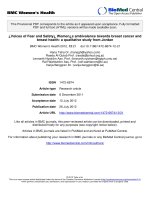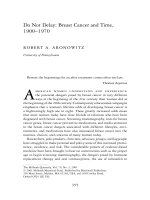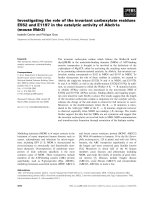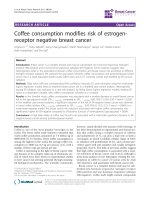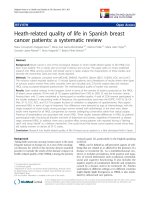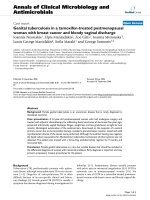Believability of messages about preventing breast cancer and heart disease through physical activity
Bạn đang xem bản rút gọn của tài liệu. Xem và tải ngay bản đầy đủ của tài liệu tại đây (430.39 KB, 9 trang )
Berry et al. BMC Psychology (2018) 6:2
DOI 10.1186/s40359-018-0213-8
RESEARCH ARTICLE
Open Access
Believability of messages about preventing
breast cancer and heart disease through
physical activity
Tanya R. Berry1* , Kelvin E. Jones1, Kerry S. Courneya1, Kerry R. McGannon2, Colleen M. Norris3,
Wendy M. Rodgers1 and John C. Spence1
Abstract
Background: The purpose of this research was to examine the relationships of self-reported physical activity to
involvement with messages that discuss the prevention of heart disease and breast cancer through physical activity,
the explicit believability of the messages, and agreement (or disagreement) with specific statements about the
messages or disease beliefs in general.
Methods: A within subjects’ design was used. Participants (N = 96) read either a breast cancer or heart disease
message first, then completed a corresponding task that measured agreement or disagreement and confidence in
the agreement or disagreement that 1) physical activity ‘reduces risk/does not reduce risk’ of breast cancer or heart
disease, 2) that breast cancer or heart disease is a ‘real/not real risk for me’, 3) that women who get breast cancer
or heart disease are ‘like/not like me’, and 4) that women who get breast cancer or heart disease are ‘to blame/not
to blame’. This task was followed by a questionnaire measuring message involvement and explicit believability.
They then read the other disease messages and completed the corresponding agreement and confidence task and
questionnaire measures. Lastly, participants completed a questionnaire measuring physical activity related attitudes
and intentions, and demographics.
Results: There was no difference in message involvement or explicit believability of breast cancer compared to
heart disease messages. Active participants had a higher confidence in their agreement that physical activity is
preventive of heart disease compared to breast cancer. Multinomial regression models showed that, in addition to
physical activity related attitudes and intentions, agreement that physical activity was preventive of heart disease
and that women with heart disease are ‘like me’ were predictors of being more active compared to inactive. In the
breast cancer model only attitudes and intentions predicted physical activity group.
Conclusions: Active women likely internalized messages about heart disease prevention through physical activity,
making the prevention messages more readily available within memory, and active women may therefore process
such information differently. The study of how health-related beliefs are created and are related to perceptions of
prevention messages is a rich area of study that may contribute to more effective health promotion.
Keywords: heart disease, breast cancer, prevention messages, believability, dual processing
* Correspondence:
1
Faculty of Kinesiology, Sport, and Recreation, University of Alberta,
Edmonton, AB T6G 2H9, Canada
Full list of author information is available at the end of the article
© The Author(s). 2018 Open Access This article is distributed under the terms of the Creative Commons Attribution 4.0
International License ( which permits unrestricted use, distribution, and
reproduction in any medium, provided you give appropriate credit to the original author(s) and the source, provide a link to
the Creative Commons license, and indicate if changes were made. The Creative Commons Public Domain Dedication waiver
( applies to the data made available in this article, unless otherwise stated.
Berry et al. BMC Psychology (2018) 6:2
Background
Physical activity is preventive of both breast cancer [1]
and heart disease [2], and is therefore promoted by breast
cancer and heart disease foundations. The work presented
here investigated the believability of messages that promote physical activity as preventive of heart disease and
breast cancer and how believability may be related to
physical activity related attitudes, intentions, and behavior.
Believability refers to perceptions of how likely, convincing, or trustworthy messages are; that is, whether the
message is believed and accepted, or read with skepticism
[3]. Researchers have examined the believability of health
promotion messages as a precursor to attitudes and related constructs. For example, O’Cass and Griffin [4]
found that the believability of anti-smoking advertisements was predictive of attitudes. Others have shown that
believability of graphic images on cigarette packages is related to increased risk perception and reduced desire to
smoke [5], that the majority of students disbelieved messages to reduce binge drinking and disbelief was related to
drinking more alcohol and reporting more hangovers than
those who believed the message [6], and that believability
of hand washing statistics is related to attitudes toward
the behavior [7]. Thus, there is evidence that general believability of health messages is related to attitudes and
should be considered when examining health promotion
or prevention messages.
Believability can also be related to specific aspects of a
message, and may be automatically activated. In such
cases, the ‘belief’ is not easily controlled and the measurement of the construct is considered implicit [8].
Huang and Hutchinson [8] developed a task that measures beliefs that automatically arise from existing memory associations after exposure to related information.
They found their measure predicted attitudes toward
commercial products and toward a health topic (hepatitis C prevention). Others used this task and found that
automatically activated beliefs and explicit believability
of exercise-for-health messages were correlated but
automatically activated and explicit believability of
exercise-for-appearance messages were not. The automatically activated belief of appearance messages was
negatively related to intentions to exercise [9]. The appeal of the task created by Huang and Hutchinson is
that it has the potential to provide additional information about cognitive responses to specific elements
within persuasive messages [8]. However, it may also
be that associations exist due to messages repeatedly
heard from other sources, such as the media. Given
this possibility, this research examined responses to
statements specific to the readings used in the research, and responses to statements that reflect how
breast cancer or heart disease are commonly perceived or represented.
Page 2 of 9
It has been shown that women feel heart disease is
more preventable and controllable than breast cancer
and that breast cancer poses a greater risk than heart
disease [10]. Thus, heart disease prevention messages
should be more believable because of stronger associations between prevention behaviors and heart disease
that have been created through learning [8]. There
should also be stronger agreement with statements of
risk for breast cancer compared to heart disease [10].
Further, although breast cancer gets a disproportionate
amount of media coverage compared to heart disease,
heart disease media messages emphasize prevention and
lifestyle behaviors such as physical activity, while breast
cancer media discusses ‘survivorship’ and screening behaviors such as mammograms [11]. There may, therefore,
be stronger agreement with a message that physical activity is preventive of heart disease compared to breast cancer. Given that heart disease is considered controllable
through lifestyle behaviors and that media emphasizes
prevention, women who do not adhere to prevention behaviors such as physical activity may be blamed for getting
heart disease. Because physical activity messages draw the
attention of people who are already active and already
have a positive attitude toward physical activity [12], physical activity status may moderate the effects of prevention
messages.
O’Cass and Griffin [4] reported that the explicit believability of anti-smoking and anti-binge drinking messages
was a significant predictor of related attitudes. They also
found that involvement with a topic was predictive of
believability and attitudes, and that attitudes predicted
intentions. They used Zaichowsky’s [13] definition and
measure that operationalizes involvement as personal
relevance based on values and interests. Thus, the
current research also examined if involvement with heart
disease and breast cancer prevention messages was related to believability, attitudes, intentions, and behavior.
Further, affective attitudes were assessed as a predictor
of physical activity, rather than instrumental attitudes,
because affective attitudes are more strongly related to
physical activity behavior [14].
The purpose of this research was to examine the relationships of message involvement, the general believability of messages that discuss physical activity as
preventive of heart disease and breast cancer, automatically activated agreement (or disagreement) with specific
statements related to the messages or diseases (i.e., automatically activated believability), and physical activityrelated attitudes and intentions to self-reported physical
activity. The specific statements represented the message
read during this research (i.e., that physical activity reduces risk of breast cancer or heart disease), reflected
more general perceptions of risk for breast cancer and
heart disease [10], reflected media messages that discuss
Berry et al. BMC Psychology (2018) 6:2
‘typical’ women who have breast cancer or heart disease,
or that women who do not engage in preventive behaviors are to blame for their disease [11]. It is hypothesized
that 1) message involvement will be positively related to
automatically activated and explicit believability; 2) automatically activated and explicit believability will be
positively related to physical activity-related behavior; 3)
more active women will show stronger message involvement, explicit believability, and automatically activated
beliefs, and 4) the relationships outlined in the first three
hypotheses will be stronger for heart disease than breast
cancer.
Methods
Participants
One hundred women aged 18 to 80 years (M = 33.05,
[SD = 16.25]) were recruited using posters and e-mail
list-serves from a university campus community, a senior’s club, and a religious institution. Given that participants contacted the researchers if they wanted to
participate after seeing recruitment information, it is not
possible to determine response rate.
Materials
Messages
The breast cancer and heart disease messages were created based on content from the Canadian Breast Cancer
Foundation and the Heart and Stroke Foundation of
Canada. The messages were as similar as possible across
the diseases and behaviors and were 155–165 words each.
Each message started with the same definition of modifiable risk factors: “Modifiable risk factors for heart disease
are factors that can be changed. These are factors that we
have more influence over and can affect us throughout our
lives. Modifiable risk factors include behaviors such as
physical activity, drinking alcohol, and smoking. We are
able to influence our level of exposure to many of these factors. By learning about them, you can take steps to reduce
your heart disease risk.” This definition was followed by
information about how and why physical activity and a
healthy body weight are related to heart disease or breast
cancer, and some risk statistics. For example, the physical
activity and breast cancer message included: “Regular
physical activity helps improve your overall physical, emotional and social health and well-being. Another important reason to get more active is that this can lower your
risk of breast cancer by as much as 25–30 per cent.” The
messages were shown on a computer and participants
read them at their own pace.
Measures
Automatically activated beliefs
As outlined by Huang and Hutchinson [8], four statement pairs (eight statements total) were presented in a
Page 3 of 9
random order with a final word or phrase missing. After
1000 milliseconds the last words appeared (the underlined sections in the statements below) and the participants agreed or disagreed as quickly as possible by
pressing a key on a computer keyboard. Participants
then gave a confidence rating for their response on a 3point scale: maybe/probably/certainly. There were two
variants of the task: one with breast cancer-related statements after reading the breast cancer messages, and the
other with heart disease-related statements after reading
the heart disease messages. The statements in both tasks
were identical with the exception of the disease name.
Within each variant (breast cancer or heart disease), one
of the statement pairs was designed to capture responses
to information about physical activity as preventive of
the disease (My risk of breast cancer/heart disease is decreased/increased by being active). One captured overall
perception of risk (Breast cancer/heart disease is/is not a
real risk for me). Another pair of statements assessed
automatic beliefs regarding if women who get the disease are like them (Women with breast cancer/heart disease are/are not like me). The final statement captured
belief that women are to blame for getting the disease
(Women with breast cancer/heart disease are/are not to
blame).
Explicit believability
The statement “The messages related to breast cancer/
heart disease are…” was rated on a 1–7 point scale with 8
adjective pairs such as believable/unbelievable, convincing/unconvincing, conclusive/inconclusive, and trustworthy/untrustworthy [3, 4]. The internal reliability was
high for the breast cancer messages, α = .89, and the heart
disease messages, α = .90. Items were reverse scored and
the mean calculated so that a higher score indicates
greater believability.
Message involvement
The statement “The messages related to breast cancer/
heart disease are…” was rated on a 1–7 point scale with 8
adjective pairs such as unimportant/important and irrelevant/relevant [12]. The internal reliability was high for
breast cancer message involvement, α = .85, and heart disease message involvement, α = .84.
Attitude
Affective attitude toward physical activity was assessed
with two items on a 1–7 scale with the pairs: pleasant –
unpleasant, and enjoyable- unenjoyable. These items
were highly correlated, r = .80, and a mean of reverse
scored items was calculated such that a higher score represents higher affective attitude.
Berry et al. BMC Psychology (2018) 6:2
Intentions
Intention to engage in physical activity was assessed with
one question: “I intend to be physically active for at least
150 minutes a week” on a 1 (extremely unlikely) to 7
(extremely likely) scale.
Leisure-time physical activity (LTPA)
Self-reported LTPA was assessed with an item validated
by Johansson and Westerterp [15] using doubly-labelled
water. Participants responded to the statement: ‘Describe
your physical activity at leisure time. If the activities vary
between summer and winter, try to give an estimate for
the average year round’. Response options were: very
light (almost no activity at all), light (light activity approximately once a week - e.g., walking, nonstrenuous
cycling or gardening), moderate (regular activity several
times a week - e.g., walking, bicycling, gardening or
walking to work 10–30 min a day), active (regular activities that cause you to breathe a bit more heavily more
than once a week - e.g., intense walking or cycling), or
very active (strenuous activities several times a week e.g., running or sports).
Demographics
Participants reported their age (in years), height and
weight (used to calculate body mass index [BMI]), smoking status, highest level of education, marital status,
household income (in increments), and ethnicity (openended). Participants also reported if they had ever been
diagnosed by a doctor or nurse with high blood pressure,
high cholesterol, heart disease, stroke, angina, diabetes,
or cancer (and if yes to cancer, what kind).
Procedure
All procedures were approved by a university health research ethics review panel and written informed consent
was obtained. A within subjects’ design was used. Each
participant read either the breast cancer or heart disease
message first, then completed the corresponding implicit
believability task and questionnaires. They then read the
other disease messages and completed the corresponding
measures. Order of message was randomly assigned to
participants such that half read the breast cancer message
first and half read the heart disease messages first.
Data analysis
A belief confidence index (BCI) was calculated for each of
the statement pairs in the implicit believability measure
using response (agree/disagree) and confidence, as advocated by Huang and Hutchinson ([8]; p. 112). The possible
score range is − 6 to + 6; a score of + 6 indicates the highest confidence in agreeing that being physically active decreases risk for heart disease (while also having the
highest confidence in disagreeing that being physically
Page 4 of 9
active increases risk of heart disease). A higher risk BCI
score indicates stronger beliefs of the real risk for getting
breast cancer or heart disease. A higher ‘like me’ BCI
score indicates belief that women with the diseases are
‘like me’ and a higher blame BCI score indicates belief that
women who get either disease are to blame. A series of repeated measures analysis of variance tests (RM ANOVAs)
examined within subject differences in breast cancer compared to heart disease message involvement, explicit believability, physical activity BCI, risk BCI, like me BCI, and
blame BCI with LTPA group as the between subjects factor. Two multinomial regression models (breast cancer
and heart disease) were used to examine intentions, attitudes, and disease specific message involvement, explicit
believability, and BCI scores (physical activity as preventive, real risk, like me, and blame), as possible predictors of
physical activity groups.
Results
Demographics
Incomplete data from three participants were not used,
and one participant diagnosed with heart disease and
breast cancer was also omitted from the analysis, leaving
a final sample of 96 who ranged in age from 18 to 80
years. Demographic data are reported in Table 1. Ten
participants chose not to answer the income question
and one did not report marital status. One participant
reported very light activity, 22 reported light activity, 27
reported moderate activity, 34 reported being active, and
12 reported being very active. Given the small numbers
in the very light and very active groups, the very light
and light active groups were combined to create an inactive LTPA group (n = 23), the moderately active group
remained at n = 27, and the active and very active groups
were combined to create an active LTPA group (n = 46).
There were no differences between order of reading and
measures (i.e., breast cancer reading and measures first
compared to heart disease reading and measures first) in
any demographic variable, nor in involvement with the
heart disease or breast cancer messages, heart disease or
breast explicit believability or physical activity belief confidence index, affective attitudes, intentions, or LTPA
group (all p > .10). There was also no difference in age,
p = .35, BMI, p = .55, nor smoking status, p = 49, by
LTPA group. Three smokers were inactive, one was
moderately active, and four reported being active.
Differences between breast cancer and heart disease
message involvement, explicit believability, physical
activity BCI, risk BCI, like me BCI, and blame BCI
Table 2 shows the means (SD) for all predictors in the
models and the correlations between constructs. There
was no difference in message involvement with breast
cancer compared to heart disease messages, F (1, 93) =
Berry et al. BMC Psychology (2018) 6:2
Page 5 of 9
Table 1 Participant demographics
Demographic variable
Age M (SD)
32.3 (15.29)
BMI M (SD)
23.3 (5.05)
Smokers N (%)
Education N (%)
Income N (%)
8 (8.3%)
High school or some college
12 (12.6%)
College or technical school
14 (14.6%)
Bachelor’s degree or higher
70 (72.9%)
< $20,000/year
17 (17.7%)
$20,000 - $39,999/year
17 (17.7%)
$40,000 - $59,000/year
15 (15.6%)
$60,000 - $79,999/year
19 (19.8%)
inactive or moderately active groups but the active group
had a higher heart disease physical activity BCI than
breast cancer physical activity BCI, p = .01, Cohen’s d =
0.54. There was a significant difference in risk BCIs, F
(1, 93) = 9.54, p = .003, Cohen’s d = 0.27, but no difference by LTPA group, F (2, 93) = 1.12, p = .33. There was
no difference in BCIs that women with breast cancer are
‘like me’ compared to women with heart disease are ‘like
me’, F (1, 93) = 2.10, p = .15, and no difference by LTPA
group, F (2, 93) = 0.99, p = .38. There was a significant
difference in blame BCIs, F (1, 93) = 32.52, p < .001,
Cohen’s d = 0.67, but no difference by LTPA group, F
(2, 93) = 1.21, p = .30.
$80,000 - $99,999/year
7 (7.3%)
Prediction of LTPA group
> $100,000/year
11 (11.5%)
Marital status
N (%)
Single
59 (61.5%)
Married
33 (34.4%)
Divorced/widowed
3 (3.1%)
Ethnicity
White/Caucasian
34 (35%)
The multinomial regression model predicting physical
activity group after reading the breast cancer messages is
summarized in Table 3. The null hypothesis can be
rejected but the model had poor fit; about 28% of the
variance was accounted for. The likelihood ratio tests
showed that only intentions and attitudes predicted
LTPA group and removing breast cancer specific message involvement, explicit believability, and all BCIs
would improve fit. The model was able to classify 65.2%
of the inactive group and 84.8% of the active group, but
only 3.7% of the moderately active group. Higher
affective attitude was related to greater likelihood of being moderately active or active compared to inactive,
and higher intention was related to greater likelihood of
being active compared to inactive.
The model predicting physical activity group after
reading the heart disease messages is summarized in
Table 3. The null hypothesis can be rejected but the
model did not fit well; about 43% of the variance was
accounted for. The likelihood ratio tests showed that
Asian or Chinese
23 (23.7%)
Indian
12 (12.4%)
Other (e.g., Arab, Filipino, Iranian, Black)
28 (28.9%)
1.81, p = .18, nor was there a difference in message involvement by LTPA group, F (2, 93) = .71, p = .50. There
was also no difference in explicit believability of the
messages, F (1, 93) = 1.83, p = .18, nor was there a difference by LTPA group, F (2, 93) = .18, p = .83. There was
no overall difference in breast cancer compared to heart
disease physical activity BCIs, F (1, 93) = 1.07, p = .30,
but there was a difference by LTPA group, F (2, 93) =
3.90, p = .02. Post hoc tests showed no differences in the
Table 2 Means (SD) and correlations between constructs; breast cancer correlations are above the diagonal and heart disease
correlations are below the diagonal
M (SD)
HD
M (SD) BC
PA
Intention
PA
Attitude
Message
Involvement
Explicit
Believability
PA BCI
Risk BCI
Like me
BCI
Blame BCI
5.51 (1.94)
5.55 (1.58)
5.86 (0.95)
5.59 (1.02)
4.66
(2.28)
1.41
(4.01)
0.53 (4.21)
−3.75
(2.64)
.164
−.012
−.066
−.069
.030
PA Intention
5.51 (1.94)
1
.357
.048
PA Attitude
5.55 (1.58)
.357
1
.385
.415
.070
−.089
−.032
−.091
Message
involvement
5.76 (0.95)
.022
.409
1
.559
.178
−.061
−.012
−.028
Explicit believability
5.70 (0.98)
.061
.343
.586
1
.103
−.173
−.051
.122
PA BCI
5.10 (2.06)
.087
.157
.136
−.067
1
−.096
−.232
.058
Risk BCI
0.26 (4.14)
−.168
−.123
−.065
.002
−.150
1
.347
−.142
Like me BCI
0.08 (4.14)
.056
−.205
−.033
−.036
−.263
.482
1
−.074
Blame BCI
−1.67
(3.47)
−.173
−.076
−.076
.091
−.144
.101
−.114
HD heart disease, BC breast cancer, PA physical activity, BCI Belief confidence index
Berry et al. BMC Psychology (2018) 6:2
Page 6 of 9
Table 3 Multinomial regression models predicting moderately active and active groups compared to the inactive group after
reading messages
Breast Cancer Model
Heart Disease Model
Model Fit
Χ = 27.63 (df = 16)
Goodness of fit
Pearson Χ = 240.51 (df = 174)
2
Χ2 = 46.23 (df = 16)***
*
2
Variance accounted for
***
Pearson Χ2 = 21.63 (df = 174)*
Nagelkerke pseudo R-square = .285
Nagelkerke pseudo R-square = .435
LTPA group
Predictor
Exp(B)
95% confidence interval
Exp(B)
95% confidence interval
Moderately Active
Intentions
1.33
.96–1.84
1.37
.97–1.94
Affective attitudes
1.87*
1.14–3.06
1.60
.98–2.62
Message involvement
0.68
.27–1.72
.91
.36–2.31
Explicit believability
0.79
.34–1.88
1.03
Active
*
.43–2.47
Physical activity BCI
1.14
.85–1.51
1.48
1.0–2.21
Risk BCI
1.04
.87–1.23
.95
.80–1.14
Like me BCI
1.04
.88–1.22
1.10
.89–1.36
Blame BCI
1.26
.95–1.66
1.05
.86–1.28
Intentions
**
1.14–2.18
**
1.58
Affective attitudes
1.88**
1.61
1.13–2.31
1.17–3.01
1.98**
1.20–3.28
Message involvement
Explicit believability
0.58
.24–1.38
0.41
.15–1.12
0.89
.39–2.04
1.62
.66–4.00
**
Physical activity BCI
1.12
.86–1.45
2.59
1.51–4.44
Risk BCI
1.04
.89–1.22
1.00
.83–1.20
*
Like me BCI
1.04
.90–1.21
1.24
1.00–1.54
Blame BCI
1.25
.95–1.63
1.11
.91–1.35
BCI Belief Confidence Index
*
p < .05, ** p < .01, *** p < .001
removing explicit believability, and the risk and blame
BCIs would improve fit. The model was able to classify
60.9% of the inactive group, 29.6% of the moderately active group, and 80.4% of the active group. Higher
affective attitudes and intentions were related to greater
likelihood of being active compared to inactive. The
additional variance in this model could be accounted for
by the physical activity and ‘like me’ BCIs. Each point increase in the BCI that being physically active reduces
risk of heart disease was related to 1.48 times greater
likelihood of being moderately active or 2.59 times
greater likelihood of being active compared to inactive.
Further, each point increase in the ‘like me’ BCI meant a
1.24 times greater likelihood of being in the active group
compared to the inactive group.
Discussion
This research examined message involvement, and the
automatically activated and explicit believability of messages about breast cancer and heart disease prevention,
and the relationships of these variables, in conjunction
with physical activity related attitudes and intentions, to
self-reported physical activity behavior. The correlations
showed that, in partial support of the first hypothesis,
involvement with both the breast cancer and heart
disease messages was related to explicit believability of
the respective messages. However, contrary to the hypothesis, message involvement was not related to any
BCI score. O’Cass and Griffin [4] also reported relationships between message involvement and explicit believability. The findings of the present research demonstrate
that message specific beliefs, operationalized through
BCI scores, are independent of explicit believability
(which is a much broader assessment of believability and
trustworthiness) and message involvement. The findings
corroborate Huang and Hutchinson’s [8] contention that
the task they developed is able to provide more nuanced
information about specific message-related thoughts,
thus providing more information about message effects.
Intention to be active was not related to any variable
other than attitudes. Attitude toward physical activity
was, however, positively correlated with both breast cancer and heart disease message involvement and explicit
believability, again supporting relationships reported by
O’Cass and Griffin [4]. Even though affective attitudes
were measured (i.e., how pleasurable they find physical
activity), higher attitudes were related to higher feelings
that the messages meant something to them, were relevant and important, and that the messages were trustworthy and convincing. Attitude was not strongly
Berry et al. BMC Psychology (2018) 6:2
related to any BCI score for either disease. Huang and
Hutchinson [8] argue that measures of explicit believability will be more related to attitudes when attitudes
are based on more accessible beliefs; the results of the
present research indicate that believing physical activity
is a preventive behavior is likely easily accessible. Correlations between belief confidence indices further showed
that participants who endorsed the belief that being
physically active will help reduce risk of breast cancer or
heart disease, had lower confidence in their beliefs that
women with the diseases are ‘like me’. Further, both disease ‘like me’ BCIs were positively related to corresponding disease risk BCIs.
Participants, regardless of their self-reported activity
level, were equally involved with the breast cancer and
heart disease messages and expressed equally high explicit believability of the messages. There was also no difference in belief confidence that women ‘like me’ are at
risk for breast cancer comparted to heart disease. These
results do not support the hypothesis that more active
women will have higher scores for these constructs.
However, active participants had higher heart disease
compared to breast cancer physical activity BCI scores.
This indicates that active participants were more likely
confident in their belief that being physically active will
help reduce risk of heart disease compared to breast
cancer. There is likely greater internalization of the message that physical activity can help prevent heart disease
by already active women and the messages may reinforce
already held beliefs. However, it is not known if the participants are active because they are, in part, aware that
being active will reduce risk of heart disease.
There was also greater belief of being at risk of breast
cancer compared to heart disease, and of perceptions of
blame, regardless of LTPA group. Although the effect was
small, women felt more at risk for breast cancer, supporting previous research that explicitly assessed risk perceptions of these diseases [10]. Regarding the belief that
women who develop one of these diseases are to blame,
the average blame BCIs were negative indicating that, in
general, the participants did not believe that women who
get the diseases are to blame. However, this effect was
stronger for breast cancer and the standard deviation for
heart disease was much larger indicating more variability
in this construct across participants. This may be related
to the sense of control some women have over heart disease in comparison to breast cancer [10].
In support of the fourth hypotheses, there were stronger relationships between heart disease message constructs and LTPA group than there were for breast
cancer. None of the breast cancer related BCIs increased
prediction of activity group. Conversely, confidence in
the belief that being active can reduce risk of heart disease was positively related to physical activity behavior.
Page 7 of 9
Also, greater confidence that women with heart disease
are ‘like me’ was related to being more active, compared
to inactive. The differences between the two diseasespecific multinomial regression models may be a function of how the diseases are discussed in the media:
heart disease is presented as avoidable through preventive behaviors whereas breast cancer is something one
survives [11]. Researchers have also reported that women
feel heart disease is more preventable than breast cancer
[10]. This may result in memory associations between prevention behaviors such as physical activity and heart disease
but not breast cancer. Understanding of the relationship
between primary prevention and breast cancer is relatively
recent. Although a 2017 review by the World Cancer Research Fund International [16] cited strong evidence of the
relationship between physical activity and decreased risk of
breast cancer, physical activity has been discussed as preventive of heart disease for far longer than it has been discussed as preventive of breast cancer. There is a need to
create more accessible beliefs regarding the relationship between physical activity and breast cancer prevention. Although the participants in the present study report explicit
believability of the breast cancer and heart disease messages, there may not be a strong enough memory trace to
automatically activate associations between breast cancer
and physical activity. Calitri and colleagues [12] report that
among active people, only those who had a strong explicit
attitude also showed attentional bias toward physical activity related stimuli, which they argue demonstrates the need
for strengthening automatic associations and finding ways
to direct attention. This may happen over time if breast
cancer is discussed as preventive of physical activity to the
same extent that heart disease is, but testing strategies such
as evaluative conditioning within interventions may offer a
way to shortcut the process [17].
This research has several strengths including a randomized within-subject experimental design with strong
measures. However, although less error variance existed
between messages because participants responded to
both disease messages, the within subjects’ design may
also have resulted in carryover effects from one reading
to the next, such that reading about one disease may
have influenced responses to the subsequently read message. This was somewhat mitigated by counterbalancing
the reading order. Another limitation is that although efforts were made to recruit a diverse sample of women,
participants were younger and for the most part highly
educated. These demographic factors might influence
perceptions of disease risk and message processing and
the results of this study should be replicated with a more
diverse sample of women. An additional consideration is
the labelling of the task developed by Huang and Hutchinson [8] as an implicit measure. Although these authors
argue that their task is implicit because participants are
Berry et al. BMC Psychology (2018) 6:2
either unaware of its intention or responses are not easily controllable, it is possible that participants considered
their responses before indicating their confidence in
their agreement or disagreement with the statements.
Nonetheless, the information provided by this task does
provide more specific information about diverse content
within the messages and highlights that various beliefs
in relation to the messages differ from each other and
can have different predictive effects.
Conclusions
This research is an important contribution that highlights
that active women hold stronger beliefs that physical activity is preventive of heart disease compared to breast
cancer. It seems likely that prevention messages created
by health promoters are processed differently by already
active women who may have internalized the messages,
making them more readily available within memory. Further, the more participants indicated that women with
heart disease are ‘like me’ the more likely they were to be
active. This may demonstrate internalization of the idea
that one is at risk for heart disease and that this may be related to decisions to be active. These results highlight that
health promoters may be at risk of reaching those already
engaged in prevention behaviors. Finding innovative ways
of reaching those who are not interested in physical activity is needed. For example, investigating if inactive women
find prevention information threatening is warranted.
Other researchers have reported that healthy women who
were moderate alcohol drinkers automatically avoided
cancer-related words after being informed that alcohol is a
risk factor for breast cancer, but self-affirmation moderated this relationship [18]. It is likely women who were
not self-affirmed found the information threatening. Further, the current research showed that breast cancer prevention messages are likely not as strongly internalized as
heart disease prevention messages. Women fear breast
cancer and greater understanding of how to mitigate these
fears, and how these fears are related to responses to prevention messages, is a rich area of study that may contribute to more effective health promotion.
Abbreviations
BCI: belief confidence index
Acknowledgements
Not applicable.
Funding
This research was supported by a grant from the Canadian Institutes of
Health Research. Tanya R. Berry and Kerry S. Courneya are supported by the
Canada Research Chairs Program. These funding bodies provided funding for
the research or the investigators but had no role in the design of the study,
data collection, analysis, interpretation of data, nor in writing the manuscript.
Availability of data and materials
The dataset used and/or analysed during the current study is available from
the corresponding author on request.
Page 8 of 9
Authors’ contributions
TRB conceived of the study, oversaw data collection, conducted data analysis
and wrote the main manuscript draft. KEJ helped in study design and data
analysis and manuscript writing. KSC, KRM, CMN, WMR, and JCS contributed
to study design and writing of the manuscript. All authors read and
approved the final manuscript.
Ethics approval and consent to participate
This research was approved by the Research Ethics Board at the University of
Alberta (reference: Pro00044542). All participants provided written informed
consent before starting the research.
Consent for publication
Not applicable.
Competing interests
The authors declare that they have no competing interests.
Publisher’s Note
Springer Nature remains neutral with regard to jurisdictional claims in
published maps and institutional affiliations.
Author details
1
Faculty of Kinesiology, Sport, and Recreation, University of Alberta,
Edmonton, AB T6G 2H9, Canada. 2School of Human Kinetics, Laurentian
University, Sudbury, Canada. 3Faculty of Nursing, University of Alberta,
Edmonton, Canada.
Received: 3 October 2017 Accepted: 10 January 2018
References
1. Schuz J, Espina C, Villain P, Herrero R, Leon ME, Minozzi S, European ZW.
Code against cancer 4th edition: 12 ways to reduce your cancer risk. Cancer
Epidemiol. 2015; />2. Perk J, De Backer G, Gohlke H, Graham I, Reiner Z, Verschuren M, Zannad F.
European Guidelines on cardiovascular disease prevention in clinical
practice (version 2012). Eur Heart J. 2012; />ehs092.
3. Beltramini RF. (1988). Perceived believability of warning label information
presented in cigarette advertising. J Advertising. 1988;17:26–32.
4. O’Cass A, Griffin D. Antecedents and consequences of social issue
advertising believability. Journal of nonprofit and public sector marketing.
2006; />5. Emery LF, Romer D, Sheerin KM, Jamieson KH, Peters E. Affective and
cognitive mediators of the impact of cigarette warning labels. Nicotine Tob
Re. 2014; />6. Polonec LD, Major AM, Atwood LE. Evaluating the believability and
effectiveness of the social norms message “most students drink 0 to 4
drinks when they party”. Health Commun. 2006;20(1):23–4.
7. Lapinski MK, Maloney EK, Braz M, Shulman HC. Testing the effects of social
norms and behavioral privacy on hand washing: a field experiment. Hum
Commun Res. 2013; />8. Huang Y, Hutchinson JW. Counting every thought: implicit measures of
cognitive responses to advertising. J Consum Res. 2008; />1086/527340.
9. Berry TR, Jones KE, McLeod NC, Spence JC. The relationship between
implicit and explicit believability of exercise-related messages and
intentions. Health Psychol. 2011; />10. Wang C, O'Neill SM, Rothrock N, Gramling R, Sen A, Acheson LS. Family
Healthware impact trial (FHITr) group. Comparison of risk perceptions and
beliefs across common diseases. Prev Med. 2009; />ypmed.2008.11.008.
11. Champion C, Berry TR, Spence JC, Kingsley BK. Pink ribbons and red dresses:
a mixed methods content analysis of media coverage of breast cancer and
heart disease. Health Commun. 2016; />2015.1050082.
12. Calitri R, Lowe R, Eves FF, Bennett P. Associations between visual attention,
implicit and explicit attitude, and behaviour for physical activity. Psychol
Health. 2009; dx.doi.org/ />
Berry et al. BMC Psychology (2018) 6:2
Page 9 of 9
13. Zaichowsky JL. Measuring The involvement construct. J Consum Res. 1985;
12:341–52.
14. Rhodes RE, Fiala B, Conner M. A review and meta-analysis of affective
judgments and physical activity in adult populations. Ann Behav Med. 2009;
/>15. Johansson G, Westerterp KR. Assessment of the physical activity level with
two questions: validation with doubly labeled water. Int J Obes. 2008;
/>16. World Cancer Research Fund International. Breast cancer. f.
org/int/research-we-fund/continuous-update-project-findings-reports/breastcancer Accessed 30 Sept 2017.
17. Papies EK. Health goal priming as a situated intervention tool: how to
benefit from nonconscious motivational routes to health behaviour. Health
Psychol Rev. 2016; />18. Klein WMP, Harris PR. Self-affirmation enhances attentional bias toward
threatening components of a persuasive message. Psychol Sci. 2009; https://
doi.org/10.1111/j.1467-9280.2009.02467.x.
Submit your next manuscript to BioMed Central
and we will help you at every step:
• We accept pre-submission inquiries
• Our selector tool helps you to find the most relevant journal
• We provide round the clock customer support
• Convenient online submission
• Thorough peer review
• Inclusion in PubMed and all major indexing services
• Maximum visibility for your research
Submit your manuscript at
www.biomedcentral.com/submit
